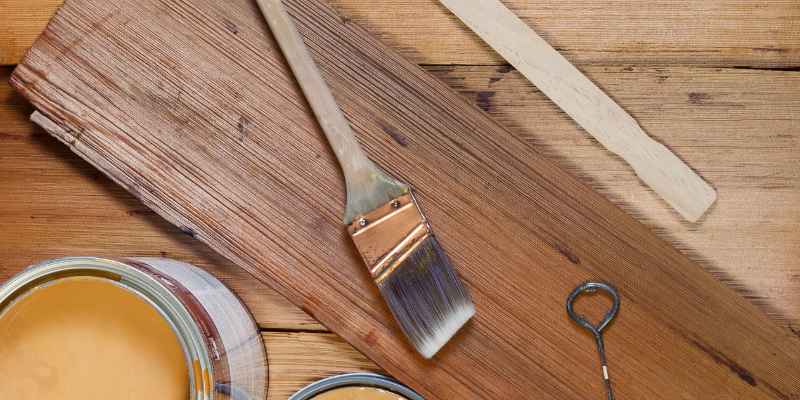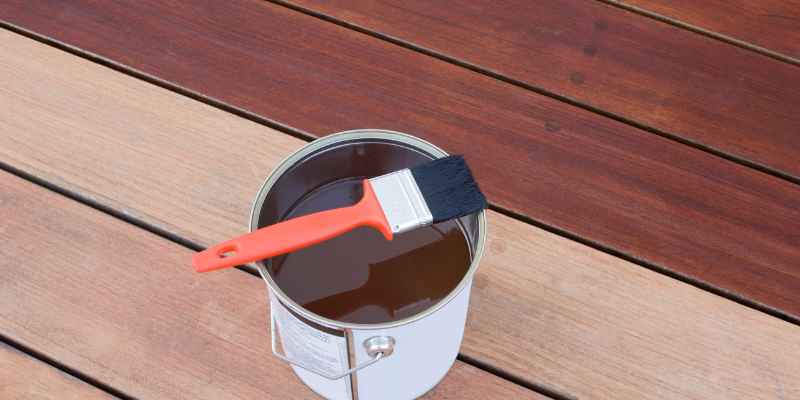Yes, you can mix wood stains to create custom colors and achieve unique finishes. Mixing different wood stains allows you to experiment and achieve the desired look for your wood projects.
Wood stains come in a range of colors and shades, and by blending them together, you can create your own custom shades and variations. This gives you the flexibility to match existing woodwork or create new and interesting finishes. Mixing wood stains requires careful testing and experimentation, as different stain brands and types may respond differently.
However, it’s a great way to personalize your woodworking projects and add a touch of creativity.
Understanding Wood Stains
Mixing wood stains can be an effective way to achieve custom colors and enhance the depth of your wood finish. By combining different stains, you can create unique shades that suit your preferences and match your desired aesthetic. Experimenting with mixtures allows for more versatility and personalization in your woodworking projects.
Different Types of Wood Stains
When it comes to woodworking and furniture restoration projects, choosing the right wood stain can make all the difference in achieving the desired finish. There are several different types of wood stains available, each with its own unique characteristics and applications. Understanding these types will help you make informed decisions and achieve the best results for your projects.
1. Water-Based Wood Stains:
Water-based wood stains consist of pigments dissolved in water and are known for their quick drying time. These stains offer a wide range of colors and are ideal for interior projects, as they emit less odor and are easy to clean up. However, they may raise the wood grain, requiring additional sanding.
2. Oil-Based Wood Stains:
Oil-based wood stains are made of pigments dissolved in mineral spirits or other solvents. They provide deep penetration into the wood, enhancing its natural grain and beauty. Oil-based stains take longer to dry, allowing for better workability, and offer excellent durability and protection against moisture. However, they can emit strong odors and require proper ventilation during application.
3. Gel Wood Stains:
Gel wood stains are thicker than traditional liquid stains, resembling the consistency of gelatin. This makes them less messy and easier to control during application, especially on vertical surfaces. Gel stains provide a uniform color and offer good coverage, making them suitable for blotch-prone woods such as pine or birch. However, they may not penetrate as deeply as other stains, resulting in a more surface-level color.
Exploring Stain Colors
Once you have chosen the type of wood stain that suits your project, it’s time to explore the wide array of stain colors available. Stains come in a variety of hues, ranging from light and natural tones to dark and rich shades. It’s important to consider factors such as the type of wood you are working with and the desired aesthetic outcome.
Lighter stain colors, such as natural or honey, enhance the natural beauty of the wood while adding a subtle touch of warmth. These are often the preferred choice for showcasing the unique grain patterns and characteristics of hardwoods like oak or maple.
Alternatively, darker stain colors, such as walnut or espresso, can bring a sense of richness and depth to your project. These tones are commonly used to create a more dramatic or antique look, especially on softer woods like pine or mahogany.
Remember, it’s always a good idea to test different stain colors on a small, inconspicuous area of your wood project before committing to a larger application. This will allow you to see how the stain interacts with the wood and determine if it achieves the desired effect.
In conclusion, understanding wood stains and their different types and colors is crucial for successful woodworking projects. Whether you opt for a water-based stain for its quick drying time, an oil-based stain for its durability, or a gel stain for better control, always consider the specific needs of your project. By exploring and experimenting with stain colors, you can transform your woodwork into stunning pieces that reflect your personal style and creativity.
Note: The above content is written in HTML format suitable for WordPress.

Mixing Wood Stains
Mixing wood stains can be a great way to customize the color of your woodwork and achieve a unique look that matches your personal style. By blending different stains together, you can create custom shades and tones that are not available as standard options. In this section, we will explore the benefits of mixing wood stains and the important things you should consider before attempting it.
Benefits Of Mixing Wood Stains
There are several advantages to mixing wood stains:
- Unique Color: One of the main benefits of mixing wood stains is the ability to create a custom color that is unique to your project. Instead of settling for the pre-mixed options available in stores, you can experiment and find the perfect combination that matches your vision.
- Customization: Mixing stains gives you the freedom to customize your woodwork according to your preferences. You can play with different ratios and intensities to achieve the desired shade, allowing you to tailor the stains to perfectly complement your existing décor.
- Cost-Effective: Mixing wood stains can be a cost-effective solution as it allows you to make use of the stains you already have. Rather than purchasing multiple cans of pre-mixed stains, blending them together can help you save money and make the most of your existing supply.
- Endless Possibilities: With the ability to mix stains, the possibilities are virtually endless. You can create various tones, gradients, or even experiment with different color families to achieve the desired effect. This gives you the opportunity to unleash your creativity and achieve a truly unique finish.
Things To Consider Before Mixing Stains
While mixing wood stains can be a rewarding process, there are a few important considerations to keep in mind:
- Compatibility: Not all stains are compatible with each other, so it is crucial to test compatibility before applying the mixture to your woodwork. Some stains may react differently when combined, resulting in unwanted or unpredictable outcomes. Therefore, it is recommended to test the mixture on a small area or scrap piece of wood to ensure compatibility and achieve the desired results.
- Ratios and Consistency: Achieving the desired color and consistency may require trial and error. By experimenting with different ratios of each stain, you can fine-tune the mixture to achieve the perfect shade. It’s important to keep track of the ratios used to ensure consistency throughout the project.
- Surface Preparation: Proper surface preparation is crucial for successful stain mixing. Ensure that the wood is clean, sanded, and free from any existing finish or residue. This will ensure that the stains blend well and achieve the desired color without any unwanted interference.
- Experimentation: Mixing stains requires a willingness to experiment and explore different combinations. It can be a fun and creative process, but remember that not all experiments will yield the desired results. Be open to learning from each attempt and adjust as necessary to achieve your desired outcome.
Mixing wood stains opens up a world of possibilities for customizing your woodwork and achieving a one-of-a-kind finish. By considering the benefits and important factors before diving in, you can create beautiful and unique colors that enhance the overall look and feel of your project.

Tips For Creating Custom Shades
Discover the art of custom shade creation and learn about the possibility of mixing wood stains. Explore tips and tricks for achieving unique and personalized shades that will add character to your woodworking projects.
When it comes to woodworking, creating custom shades with wood stains can add a unique touch to your projects. Mixing different wood stains allows you to achieve the perfect color and match existing wood pieces. If you’re looking to experiment with different shades and create your own customized colors, here are some helpful tips to get you started:
Start With Similar Stain Colors
To ensure a smooth blending process, it’s important to start with wood stain colors that are similar. Mixing stains of the same brand and type will give you better control over the end result. Avoid mixing oil-based stains with water-based stains as they may not blend well together. Having similar stain colors as your base will provide a solid foundation for creating your desired custom shade.
Adjusting The Ratios
The ratio of each stain color you use will determine the final shade. Start by mixing small amounts of each stain color and gradually adjust the ratios until you achieve the desired hue. Keep in mind that adding more of one color will intensify its influence on the final shade, while reducing the amount of a color will help soften its tone. It’s crucial to document the ratios used, so you can replicate the shade in larger batches if needed.
Testing On Scrap Wood
Before applying your custom mixed stain to your project, it’s essential to test it first on scrap wood of the same type. This allows you to see the color result without any surprises on your actual project. Apply the mixed stain to the scrap wood, let it dry completely, and observe if it matches your vision. Making adjustments and tweaks on scrap wood will help you avoid any irreversible mistakes on your final piece.
Blending Techniques
There are various blending techniques you can use to create custom shades. One method is wet-on-wet blending, where you apply a second color while the first color is still wet. This technique allows the colors to blend seamlessly, creating a harmonious effect. Another technique is layering, where you apply multiple coats of different colors, allowing each coat to dry before applying the next. This method can create depth and complexity in your custom shade.
In conclusion, mixing wood stains to create custom shades can elevate the beauty of your woodworking projects. By starting with similar stain colors, adjusting the ratios, testing on scrap wood, and employing blending techniques, you can achieve unique and personalized hues. Remember to document your ratios for future reference and always test on scrap wood before applying the custom mixed stain to your project. With these tips in mind, let your creativity shine by creating your own custom wood stain shades.
Conclusion
Mixing wood stains gives you the freedom to create unique and personalized finishes for your wood projects. However, it’s important to note that the outcome can be unpredictable and may require some trial and error. By following a few guidelines and experimenting with different mixtures, you can achieve stunning results that enhance the beauty of your woodwork.
Embrace the versatility and creativity that mixing wood stains offers, and enjoy the process of transforming your projects into true works of art.


